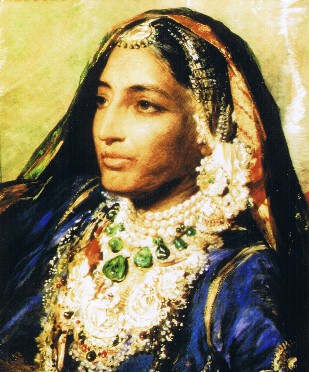Maharani Jind Kaur

Jind Kaur was born in 1817 in the village of Chhahar, District Sialkot, Punjab, now in Pakistan (Singh, T, 1959). She was the eldest of three sisters and two brothers of Manna Singh Aulakh, a Sikh of the Jat caste.
Jind Kaur’s father came to Lahore, where he became the Royal kennel keeper in the service of Ranjit Singh (1780-1839), the Maharajah of the Punjab and sovereign of the Sikhs.
The Maharajah was said to have been pestered day and night by Manna Singh, who told him that his daughter was the most beautiful creature in the world, whom he would give to the Maharajah as his wife and that she would make the old Maharajah young again.
The Maharajah married Jind Kaur in 1835, by the ceremony of Karewa. In 1838 she gave birth to a son, Duleep Singh, who became the Maharajah in 1844 after the death of three successive monarchs following the death of his father Ranjit Singh in 1839. Jind Kaur was appointed the Regent.
During this period of internal politics and unrest, the Maharani’s illicit affairs and flirtations with her ministers came to light, and whilst her power began to slip, the Sikh Army became increasingly powerful and out of control. In November 1845 The Maharani despatched the Sikh Army to the borders of the River Sutlej, to confront the British, who were camped provocatively on her southern border. Unknown to her, her two treacherous generals had sold themselves to the British. The result being, two hard fought Wars, the First Anglo-Sikh War of 1845-46 and the Second Anglo-Sikh War 1848-49. The finale being the annexation of the entire Punjab and the dethronement of her son Duleep Singh in 1849, who became a ward of the British under the care of John Login, and exiled to England five years later.
Jind Kaur met a very different fate. After the First Sikh War she had lost complete power, as a Council of Regency was set up under the British Resident, Henry Lawrence, who found the Maharani’s attitude rebellious and threatening to the British Empire, and ordered her to the Summan Tower of the Lahore Fort.
She called for an enquiry and appealed for justice, including the separation of her nine year old son Duleep Singh from her, and the non-payment of her allowance of one and a half lakh rupees as laid down in the Treaty of Bhyrowal (1846). The resident could not tolerate her pressure in Lahore. On the 19th August 1847, Duleep Singh was sent away from the palace, the same night the Maharani was removed from Lahore and incarcerated in the Fort of Sheikhapura. She was later transferred to Ferozepur on the 15th May 1848 and her income was reduced to Rs.1,000 per month (Punjab Papers, 1849). In 1849 after the annexation of the Punjab she was shifted to Fort Chunar but on the 18 April of that year she escaped, disguised as a slave girl, and arrived at Kathmandu ten days later, under the protection of the Nepalese Government. Lady Login described her as a ‘practical prisoner in Nepal, under Jung Bahadur, who grudged her of her every penny of the pension he said he allowed her.’
In 1860, her son, now an English aristocrat, sought to make contact with his mother through the resident at Kathmandu, Col Ramsay, who remarked that ‘The Rani had much changed, was blind and lost much of the energy which formerly characterised her, taking apparently but little interest in what was going on.’
Jind Kaur and her son met at Spence’s Hotel, Calcutta, on the 16th January 1861, after some thirteen and half years apart. She was granted permission to come to England. A residence was taken up at No. 1 Lancaster Gate (Now No.23). Lady Login remarked on meeting Jind Kaur in 1861, ‘Jinda Kour was truly an object of commiseration when one contrasted her present with her former state…Health broken, eye sight dimmed, her once famed beauty vanished, it was hard to understand the power she had wielded through her charms, It was only when she grew interested and excited in conversation, that one caught glimpses, beneath that air of indifference and the torpor of advancing age, of that shrewd and plotting brains which had distinguished the famous ‘Messalina of the Punjab’
After a short spell at Mulgrave Castle, she was placed in the charge of an English lady at Abingdon House, Kensington. On the morning of the 1 August 1863, Maharani Jind Kaur passed away peacefully, her estate on her death valued at a mere £12,000 (Probate Registry) Her body was temporarily housed at London’s Kensal Green Cemetery, and in the Spring of 1864, Duleep Singh left for India and arranged for the cremation of her body.
Jind Kaur was cremated at Nasik in Bombay on the Panchvati side, on the left bank, where a small samadh (memorial stone) was built. For a number of years the Kapurthala State Authorities maintained the memorial until 1924, when her remains were dug out and brought to Lahore by her grand-daughter, Princess Bamba Sutherland and deposited at the Samadh of Maharajah Ranjit Singh.